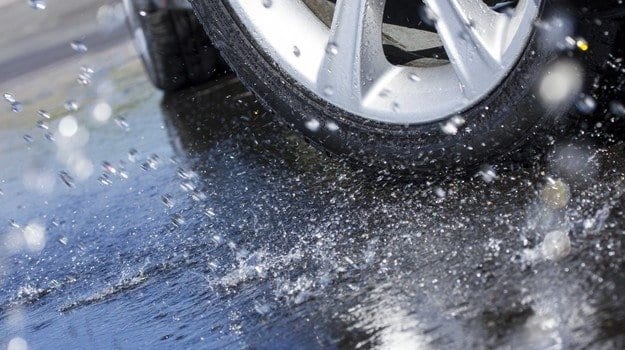
Test drive water on the road - danger signal

Helpful hints: how to avoid the aquaplaning phenomenon
You need to go in the fall, even in bad weather. Rain-soaked roads are a prerequisite for hazardous aquaplaning. Fortunately, a few simple precautions can ensure a safe and restful journey.
Aquaplaning turns the driver into a spectator
Aquaplaning is a real threat in late summer and autumn. When the tire tread cannot push all the water that is between the tire and the road, the "interaction" between the two is lost and grip disappears.
In the case of aquaplaning, it is important to stay calm.
“If your car gets into hydroplaning, take your foot off the accelerator and depress the clutch. Do not use the brake or turn the steering wheel. When you slow down, the clutch may suddenly come back. When this happens, you need your tires to point in the right direction, not the opposite,” says Martin Drazik, Product Manager at Nokian Tires.
Check tires and pressure regularly
Fortunately, you can easily reduce your risk of hydroplaning before you even get behind the wheel. The first way is to regularly check the tread depth of the tires and make sure they are in good condition. Worn tires push out water much less because the tread no longer has the necessary ability to collect water.
“The legal minimum tread depth is 1,6mm, but keep in mind that tires lose their hydroplaning properties even by 4mm,” Drazik says.
In a recent test by Tekniikan Maailma magazine (May 2018), worn tires hydroplan at 75 km/h. The best new tire hydroplans at 85 km/h during the test. In addition to the tread depth, tire pressure must also be checked. Low pressure increases the risk of hydroplaning. Checking and possibly inflating your tires are important safety measures that won't cost you anything at the next gas station.
Correct speed helps you control
You can also prevent hydroplaning while driving. The most important thing is to always maintain the correct speed. On the road, never rely blindly on technology or take the speed limit as the minimum for driving. Even new tires may not prevent hydroplaning if you drive too fast in heavy rain.
“The most important precaution a driver can take is to adjust the speed according to the situation and weather conditions. In heavy rain, you need to slow down by 15-20 km / h so that the tread pattern can remove all the water between the tire and the road surface,” recalls Drazik.
Allow yourself more time to travel in rainy weather to relieve any pressure and move faster. It is also extremely important to maintain the correct safety distance to other vehicles, as the braking distance increases on wet roads. Be careful with the road surface itself. As you know, roads wear out, potholes and ruts appear, which can be very deep.
“If there are caterpillars, do not drive into them, as they collect water. Trails are much safer to ride than them,” Drazik says.
Remember these tips in rainy weather
1. Check the tread depth of your tires. The recommended minimum tread depth is 4mm.
2. Check the tire pressure. Under-inflated tires turn slower and also increase fuel consumption.
3. Adjust the speed according to the weather conditions. In heavy rain, you need to reduce the speed by 15-20 km / h.
4. Move calmly. Maintain a safe distance and drive at a reasonable speed.
5. Pay attention to the road surface. Do not ride on rails as they collect water.
